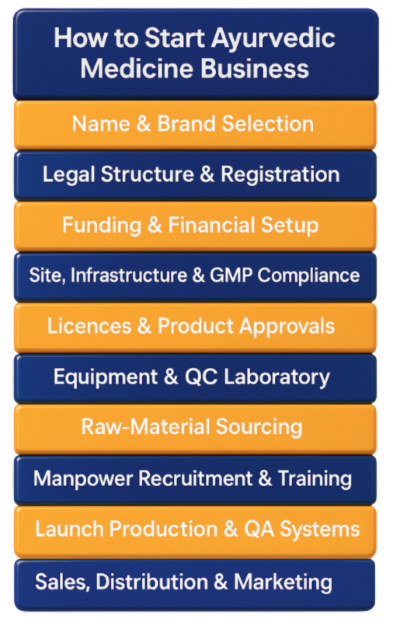
Ayurveda is experiencing a global advancement, driving substantial growth in the Indian Ayurvedic medicine market. The market reached $10.3 billion in 2024 and is projected to reach $42.2 billion by 2033, exhibiting a CAGR of 16.2%. The Ministry of AYUSH market grew from $2.85 billion in 2014 to $43.4 billion in 2023, with Ayurvedic product exports doubling.
This growth, coupled with government support, presents lucrative opportunities for entrepreneurs. Success in the Ayurvedic medicine business, however, requires careful planning, quality adherence, and market understanding.
This blog will cover essential aspects like market research, business planning, GMP-ready factory design, State Licensing Authority (SLA) licenses, and growth strategies. While the checklist is extensive, methodical adherence will help with the launch of a reputable and scalable Ayurvedic manufacturing venture.
Process to Starting an Ayurvedic Medicine Business
The steps to establish an Ayurvedic manufacturing unit are as follows:

1. Name & Brand Selection
Your company’s name is its identity, so make it count! Use our company name checker to ensure it’s unique and not already taken. This step is crucial for legal reasons and helps in building your brand identity. Think about something that reflects the values of Ayurveda and resonates with your target audience.
The same goes for the medicine brand or the product’s name. Just like popular brands have unique names for their products, you’ll need catchy and easy-to-remember names for each of your Ayurvedic medicines. These names should be easy to spell, pronounce, and recall, making them more appealing to customers. Consider the specific benefits or ingredients of each product when choosing a name.
2. Legal Structure & Registration
- Decide on a legal structure: You’ll need to decide how your business will be legally structured. Below are the options available for company registration:
| Structure | Pros | Cons |
| Private Ltd. | Easy fundraising, limited liability | Higher ROC compliance |
| LLP | Flexible ownership, lower ROC fees | Fewer funding routes |
| Partnership and Sole Proprietorship | Simple setup | Unlimited liability |
Each has its pros and cons in terms of liability, taxation, and compliance, so choose wisely.
- File incorporation and obtain key registrations: Once you’ve chosen your structure, you’ll need to register your business. This usually involves filing incorporation documents with the Registrar of Companies (RoC). You’ll also need to obtain a Permanent Account Number (PAN), Tax Deduction and Collection Account Number (TAN), and Goods and Services Tax Identification Number (GSTIN). And don’t forget to open a current account in a bank for your business transactions.
- Apply for a municipal trade licence and enrol on the Udyam portal: To operate legally in your city or town, you’ll likely need a municipal trade license. This license permits you to carry out your specific business activity. Additionally, enrolling your business on the Udyam (MSME) portal can make you eligible for various government incentives and support programs designed for micro, small, and medium enterprises.
3. Funding & Financial Setup
- Estimate your Capital Expenditure (capex): Starting an Ayurvedic manufacturing unit requires a significant initial investment. You’ll need to estimate the costs for land (or lease), Good Manufacturing Practices (GMP)-compliant civil works, machinery, setting up a Quality Control (QC) lab, the initial batch of raw materials, license fees, and your ongoing working capital (day-to-day expenses).
- Secure funding: You can finance your business through personal savings (bootstrapping), bank loans (like Mudra or CGTMSE), government subsidies for AYUSH, or by attracting investment from angel investors or VC firms. Carefully research each option to determine the best fit for your needs and risk tolerance.
- Implement basic ERP/accounting: From the beginning, it’s essential to have a system in place to manage your finances, inventory, and production. The system will help you track raw materials, manage batch production, monitor sales, and ensure you’re on top of your business’s financial health.
4. Site, Infrastructure & GMP Compliance
- Reserve GMP-compliant floor space: Manufacturing Ayurvedic medicines requires a dedicated space that meets strict hygiene and safety standards. You’ll need to allocate sufficient floor space (at least 1,285 sq ft) and design it according to GMP guidelines. This includes areas for storing raw materials, processing, quality control, storing finished goods, and a quarantine area for materials awaiting testing.
- Build compliant infrastructure: The facility itself must adhere to specific standards. This means constructing sanitary walls, installing non-shedding floors, and ensuring pest-proof ceilings.
- Obtain necessary clearances: Before you can begin operations, you’ll need to obtain several clearances. This includes a Fire-Safety No Objection Certificate (NOC), Pollution Control Board Consent, and, depending on the scale and nature of your operations, you might also need environmental clearance.
5. Licences & Product Approvals
- Obtain AYUSH Manufacturing Licence and GMP certificate: To legally manufacture Ayurvedic medicines, you must obtain an AYUSH Manufacturing Licence (Form 24-D) and a GMP certificate. These are granted by the State Licensing Authority (SLA) after a thorough inspection of your facility to ensure it meets the required standards.
- Register each formula: Every Ayurvedic medicine you plan to manufacture, whether it’s a classical formulation or a proprietary one, needs to be registered. This involves providing a detailed list of ingredients, their proportions, and proper labeling information. Accurate and compliant labeling is crucial for product safety and regulatory adherence.
- Apply for GST: If you plan to sell taxable goods across different states in India, you’ll need to register for GST. This allows you to collect and remit the applicable taxes, ensuring compliance with the national taxation system.
6. Equipment & QC Laboratory
- Procure machinery: The type of machinery you need will depend on the dosage forms you intend to produce (e.g., tablets, capsules, liquids, powders). Common equipment includes pulverizers, sifters, mixers, tablet presses, capsule fillers, HDPE packing machines, etc. Ensure your machinery meets AYUSH specifications.
- Set up a QC lab: Quality control is paramount in Ayurvedic medicine manufacturing. You’ll need a well-equipped Quality Control (QC) lab to test raw materials, monitor in-process quality, and analyze finished products. The lab should ideally be NABL-accredited (National Accreditation Board for Testing and Calibration Laboratories), or you can outsource testing to a reliable NABL-accredited lab.
7. Manpower Recruitment & Training
- Hire qualified professionals: You’ll need to recruit qualified personnel to oversee your manufacturing operations. This includes at least one Manufacturing Chemist and one QC Chemist, both with qualifications like a Bachelor of Ayurvedic Medicine and Surgery (BAMS) or Bachelor of Pharmacy (Ayurveda).
- Recruit supporting staff: In addition to the core technical team, you’ll need production operatives, packaging staff, maintenance personnel, a Quality Assurance (QA) team, and administrative staff to handle the day-to-day operations of your business.
- Conduct regular training: To ensure consistent quality and safety, it’s essential to provide regular training to all your staff. This training should cover GMP guidelines, Standard Operating Procedures (SOPs), safety protocols, and any other relevant skills needed for their specific roles.
8. Launch Production & QA Systems
- Install and validate machinery: Once you have your machinery, ensure it is installed according to AYUSH specifications. You’ll also need to validate and calibrate the equipment to ensure it’s functioning correctly and producing consistent results.
- Develop SOPs and protocols: Establish clear Standard Operating Procedures (SOPs) for every stage of the manufacturing process, from raw material handling to packaging. You’ll also need to create Batch Manufacturing Records (BMRs) to document each batch produced and implement Quality Assurance release protocols.
- Start pilot production and scale: Before full-scale commercial production, begin with pilot batches to test your processes, refine your formulations, and gather data. Conduct thorough stability tests to determine the shelf life of your products.
9. Sales, Distribution & Marketing
- Decide on a distribution model: You’ll need to decide how you want to get your products to the customers. Common models include manufacturing for your own brand, producing for third-party marketing companies, or a combination of both.
- Establish online and offline presence: To reach a wider market, you’ll need both an online and offline strategy. This includes listing your products on your own website, selling through e-commerce platforms like Amazon, Flipkart, and Snapdeal. The process often also includes partnering with offline distributors to get the products into retail stores and pharmacies.
- Promote ethically: When marketing your Ayurvedic medicines, it’s crucial to do so ethically. Focus on highlighting the authentic ingredients, the quality of your manufacturing processes, and the traditional knowledge behind your products. Avoid making any exaggerated or misleading therapeutic claims, as this can lead to legal issues and damage your reputation.
Documents Required to Start Ayurvedic Manufacturing Unit
A list of documents needed to start Ayurvedic medicine business is mentioned below:
- Application for the issuance of a license to produce unani, siddha, or ayurvedic medications (Form 24D for New License and Form 24E for Loan License)
- Fee Challan
- Aadhar Card/PAN Card of the owner (in the case of a proprietorship), partners (in the case of a partnership firm), or directors (in the case of a public limited company or private limited company)
- Provide evidence of the premises (such as a rent or sale agreement, an electricity or water bill, etc.).
- List of technical personnel, such as manufacturing and analytical chemists, together with supporting documentation in the form of technical and instructional materials and identification
- Site Master File or Premises Blueprint
- Enumeration of apparatus and laboratory supplies
- The list of medications to be produced comprises product data such as the brand name, the herbs and their components utilised, the page number of each herb in the reference book, the form (such as powder or extract, etc.), the preservatives used, the recommended uses of the product, etc.
- Details on the electrical supply, such as an electricity bill
- NOC (if any)
- Additional papers that the concerned officer would want throughout the inspection and application filing process
Government Licenses & Certifications For Ayurvedic Manufacturing Business
Every business needs a set of documents, certifications, and licenses for establishment. Let’s start with the crucial legal requirements an ayurvedic manufacturing venture needs to adhere to:
Obtain Essential Licenses
Here are some licensing requirements every entrepreneur needs to apply for before starting an ayurvedic manufacturing business:
| License / Approval | Form | Renewals |
| Manufacturing License | Form 24-D (+ site master file, tech staff, machinery list) | Every 5 years |
| Product Approval (classical) | Reference to text + label draft | With license |
| Product Approval (proprietary) | Formula, safety/efficacy data | — |
| GMP Certificate (part of the license) | — | Aligned with the license |
| Pollution Control NOC | — | 3–5 yrs |
Credibility-Boosting Certifications (Optional)
- AYUSH Standard / Premium Mark (QCI)—Premium aligns with WHO-GMP.
- ISO 9001, WHO-GMP (export), Organic (NPOP/USDA/EU), HACCP (food-like SKUs).
How Can an Ayurvedic Marketing Business Be Initiated?
Before launching an ayurveda manufacturing firm, it’s essential to understand the market and availability of ayurvedic medications. Ensure your business is registered as a proprietorship, partnership, limited liability company, or public company.
Apply for a trade license from your local municipality and GST registration with the central department. Once you have the Trade License, GST Registration Certificate, and Company Registration Certificate, you can open a current account at any nationalized bank.
To obtain a manufacturing license for Ayurvedic, Siddha, Unani, or homoeopathic medicines, you need to establish a manufacturing plan and submit an application to the AYUSH Ministry along with the required documents and fees.
For a smoother startup process, consider contacting an expert like RegisterKaro for assistance.




